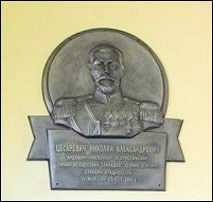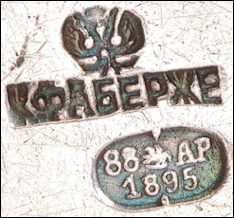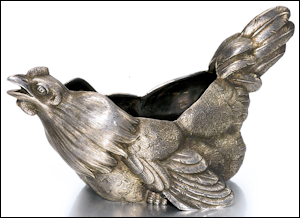
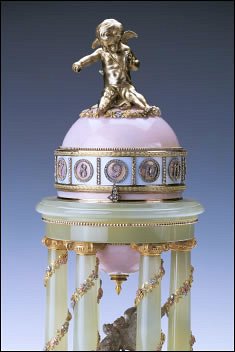
(Royal Collection Trust © Her Majesty Queen Elizabeth II, 2013)
It comes as no surprise that a number of the famous Imperial Easter Eggs followed suit and owing to their uniquely important place in the history of Fabergé’s patronage they are some of the most extravagant expressions of “Neo-neo-Classicism” made by the firm. The allusions to antiquity evident in Fabergé’s Eggs provided Alexander III with the means of delivering covert messages of love to his wife Marie Feodorovna. After Alexander’s death in 1894, his son Nicholas II took over the responsibility of commissioning the Easter Eggs but subsequently there was a need for two; one for his mother and one for his wife. Of necessity the messages of love were subtly different. Those for the Dowager Empress Marie were affectionate but those for his beloved wife Alexandra were amorous. Nonetheless, some of the same rebuses and metaphors appear in the design of both and they include many of the attributes of Venus. Rose buds and garlands stand for the pleasure and pain of love; rubies are for passion; pearls like Venus are born of the sea; diamonds are forever and arrows are the foremost attribute of Cupid.
The meaning of these allusions, including those associated with the fashionable language of flowers and the lore of the lapidary, was obvious to Fabergé and to his customers. However, after the first quarter of the 20th century, when classical educations were already in decline such allusions appeared increasingly obscure. In the geometric world of Art Deco, the slump of the 1930’s and post war austerity, few could be bothered to decipher these seemingly anachronistic messages. If they were received at all it was subliminally. Consequently, only a small effort was made to emphasize the emblematic meanings of the famous Fabergé Eggs, let alone the less important pieces made by the firm where Neo-neo-Classical allusions are found in abundance. What follows is an expansion of the meaning of the Colonnade Egg and the proposal of a new source of inspiration.
It is said every Imperial Easter Egg contained a surprise but in some instances this took the form of clock mechanisms and they surely allude to the Roman poet Virgil (70-19 B.C.) and his famous hemistitch, Tempus Fugit Semper Amici – Time flies but love remains. A notable example of the style, probably inspired by a Neo-Classical type, made popular in the reign of Louis XVI by the French porcelain factory Sèvres, is the Serpent Egg Clock of 1895. Almost certainly approved by Alexander III the Egg became an emblem of love beyond the grave as it was delivered only months after his death, at Easter the following year. Enameled blue for love, it is garlanded with colored gold roses and the hours are indicated with a snake. This is no ordinary snake but an ancient symbol of eternity called the ouroboros. In the case of the Serpent Egg Clock its message of constancy and permanence is endorsed with diamonds.
Fifteen years later the covert meaning of the Serpent Egg Clock sets the scene for possibly the most extravagant expression of the Neo-neo-Classical style ever made by Fabergé, namely the Colonnade Egg of 1910. This improbable object was meant to commemorate the arrival of the long-awaited Romanov heir, Tsarevitch Alexei, born in 1904. To Nicholas and Alexandra, oblivious of the tragedy to come, Alexei’s arrival brought not only domestic bliss but assured the succession of the Romanovs; bells tolled out the happy news throughout the land and a 301-gun salute was fired in St. Petersburg. Eventually, Fabergé was put to work to commemorate the joyful occasion in the form of an Imperial Easter Egg. Alexei was not just the heir to throne but to his parents, the pious Nicholas and Alexandra, “Baby Love” was the God-given endorsement of a passionate love match. Nicholas wrote in his diary the day his son and heir was born: “A great and unforgettable day for us, during which we were clearly visited by the grace of God”.
At the time of the Tsarevitch’s birth Russia was in the grip of a disastrous war with Japan and Alexei’s arrival helped to dispel the gloom prevailing throughout the land. Grand Duchess Xenia said, “The nation was really in the depths of a depression because of the disasters in Manchuria. All the same, I remember how happy the people looked when the news was announced”. Eventually no expense was spared with Fabergé in articulating the joyful tidings.
The Imperial Easter Eggs were some of the most complicated and technically challenging of the commissions given to Fabergé and it is likely the majority of these took not months but years from Imperial approval to completion. For instance, the Coronation Coach Egg was delivered more than two and half years after the accession of Nicholas II in October 1894. In pondering the gap between Alexei’s birth and the delivery of the Colonnade Egg it is worth remembering Fabergé was amply forewarned of coronations and anniversaries. However, time must have been tight to design and make a fitting tribute to the birth of a Romanov baby, let alone a long-awaited Tsarevitch.
Despite these difficulties an Egg in the Louis-Style was delivered by Fabergé for Easter 1907. Once called the Love Trophies Egg, it is now called the Cradle with Garlands Egg. Its recent appellation was made to endorse the Egg as an emblem of Alexei’s birth and is based on a quotation by Fabergé’s senior designer Franz Birbaum: “The appearance and the contents were sometimes adapted to family events – for instance, when the heir to the throne was born, the Easter egg suggested was a cradle decorated with garlands of flowers, and contained the first portrait of the heir in a medallion surrounded by diamonds”.
It is possible Fabergé may have conceived the Cradle with Garlands Egg before Easter 1907 and that it was indeed “adapted to family circumstances”, since it is much less a cradle than an oviform Arcadian altar of love complete with the usual attributes of arrows and roses. Probably because of the technical constraints referred to above, it was more than four years after Alexei’s birth before an unambiguous and suitably lavish tribute to his arrival was delivered by Fabergé to Nicholas II with a bill for 11,600 rubles. Today this is known as the Colonnade Egg.
Once again the Louis-Style was the order of the day and the Colonnade Egg was designed in the form of a miniature Arcadian temple of Love supporting the mandatory egg. This was a technically demanding masterpiece made of lapidary work, bound with colored gold and decorated with Rose Pompadour enamel. At the center of this shrine to Imperial Love is one of the foremost attributes of Venus, a pair of billing doves rendered incorruptible in platinum. The foot of the temple is flanked by four “putti”, but not strictly so because in this instance these were girls, not boys. According to a Fabergé record book they represented the Tsarevitch’s sisters Olga, Tatiana, Maria and Anastasia. Naturally the icing on this already very rich confection, virtually a bejeweled wedding cake, was the Tsarevitch. We see him astride the top, way above his sisters, in the guise of a winged amorino. With a wand (now missing) Alexei pointed to the hours on the annular dial of the clock which was made by the Swiss firm of Henry Moser & Cie. This was not only another reference to Virgil’s hemistitch Tempus Fugit Semper Amici but perhaps a subtle reminder of how long Nicholas and Alexandra had yearned for his arrival. Nicholas’s cousin, Grand Duke Konstantin Konstantinovich, said it all in his diary: “God has sent their Majesties a son. What a joy! Russia has waited 10 years for an Heir and now it has happened”.
In working up the spell of this emblematic Egg Fabergé may well have turned to engravings of the famous Temple of Venus built in 1777 by Richard Mique (1728-1794) for Queen Marie Antoinette in the gardens of Le Petit Trianon at the Palais de Versailles. However, there was a similar “Temple of Love” designed and finished to the order of Catherine the Great in the gardens of Pavlovsk.* It was inspired by a didactic fairy tale written by the Empress for the betterment of the moral values of children and remained popular with the Romanov family. Certainly, the Colonnade Egg is based on the kind of pastoral architecture which was common throughout Europe in the 18th century. Indeed the invoice from Fabergé seems to substantiate the idea. There the Imperial Easter Egg was described as: “Large clock egg in the form of a Summer house”.
In 1953 Sir Sacheverell Sitwell (1892-1988), the 6th baronet, wrote the foreword to Carl Fabergé, the catalog of Wartski’s Special Coronation Exhibition. The Colonnade Egg (object #46) was lent from the collection of Her late Majesty Queen Mary. He suggested Fabergé may have been inspired by illustrations to the poem “Les Baisers” (The Kisses) by Claude Joseph Dorat published in 1770.

Temple Built for Catherine the Great
in the Gardens of Pavlovsk
(Colored Print, Courtesy Private Collection)
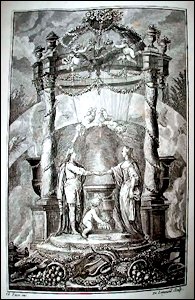
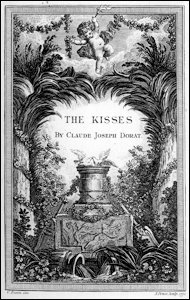
Temple of Love and Doves of Venus Engravings by Charles-Dominique-Joseph
Eisen (1720-1778) to illustrate the poem “Les Baisers” by Claude Joseph Dorat
published in 1770. The lovers are crowned by putti against a background of
the symbols of the Zodiac. The dial of astrological symbols may have
inspired the annular movement of the Colonnade Egg. Above is the
coronation of a double-headed eagle.
(Courtesy London Library)
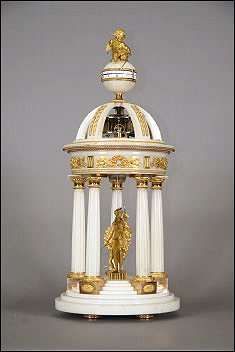
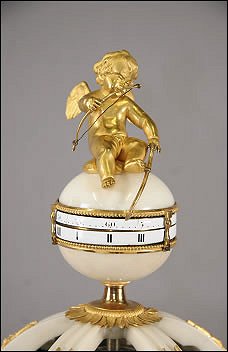
A White Marble and Ormolu Clock Designed as the Temple of Diana, French, ca.1770
(Courtesy Cortot-Vréügille-Bizouard SVV, Dijon, France)
*I am grateful to Galina Korneva and Tatiana Cheboksarova for drawing my attention to the temple at Pavlovsk and its association with the Romanov family.
Contributed by Jim Hurtt, a regular observer at the New York Russian auctions, with research assistance by Christel Ludewig McCanless
Christie’s New York sale on April 15, 2013, enjoyed a 94% sell rate – of the 63 Fabergé objects offered all but four sold. Christie’s saw multiples of their estimates for a distinguished Midwest Private Collection coupled with additional choice pieces.
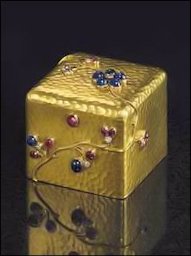
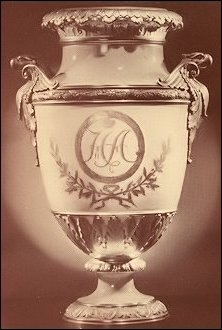

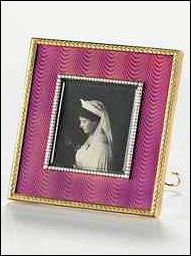
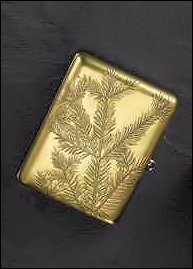
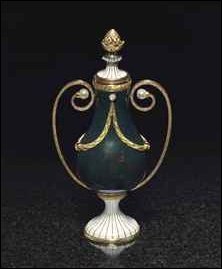
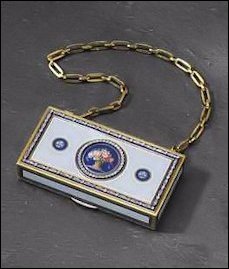

Christie’s New York, April 15, 2013 Auction: Jeweled Box (Lot 32) – Vase (48) – Frame (11) – Cigarette Case (7) – Gum Pot (29) – Vanity Case (59) – Inkwell (30)
(Archival Photograph, Hammer Galleries, New York)
An interesting piece with an English royal family provenance is a gold mounted frame with fuchsia enamel over wavy moiré guilloche ground (Lot 11). The inner opening is bordered by seed pearls. Queen Alexandra of England purchased it on November 13, 1911, for €24, or $120. It sold over a hundred years later for $68,750, almost double of the high estimate. Based on my observations over the years that is really rather reasonable given its provenance and beauty. It is easily worth $200,000 or more. Another piece with a Russian Imperial and British Royal provenance, a gold cigarette case (Lot 7) purchased by Tsar Nicholas II and his mother Maria Feodorovna in 1900 and perhaps gifted to Queen Mary’s brother, Adolphus, 1st Marquess of Cambridge (1868-1927), or to another member of her family who then gave it to him. It sold at the top range of the estimate – $30,000. A reasonable price given its provenance complete with a letter and an original box, the Moscow piece is very attractive.
Several dealers, collectors, and agents competed for an exquisite gold, bloodstone and enamel gum pot by Henrik Wigström (Lot 29) which once belonged to the Forbes Magazine Collection. The bidding ended at $123,750. Two more objects from the same workshop documented in Tillander-Godenhielm, et al., The Golden Years of Fabergé: Drawings and Objects from the Wigström Workshop are lots 59 and 30. The gold and enamel vanity case (Lot 59) sold for $117,500. Money well spent as it is quite chic and elegant, and dates from 1914, or at least the similar design does. A rock crystal and gold inkwell (Lot 30) with a design sketch realized $56,250, or just a little over the low estimate. It really should have sold for $100,000. In a 1979 auction the inkwell was offered by the perfume company, Fabergé, Inc., selling for $15,000, and in 1997, again in New York, it sold for $57,500. Someone got a bargain as it is quite interesting and elegant.
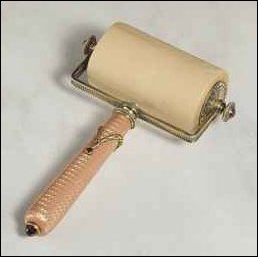
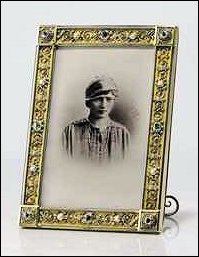
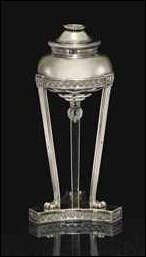
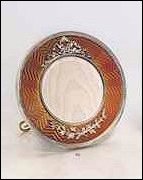
Christie’s New York, April 15, 2013 Auction: Rolling Blotter (17) – Frame with Grand Duchess Tatiana Photograph (28) – Table Lighter (15) – Frame (62)
Fabergé frames are perhaps too common right now as a few in the auction did not sell or only sold at estimates within their range. Lot 28, a frame with a photograph of Grand Duchess Tatiana Nikolaevna, sold for almost a $100,000 having an estimate of $40,000-$60,000, and the fuchsia enameled frame (discussed in section one above) doubled its estimate, but the two frames in lots 52 and 55 (not illustrated) failed to sell. Their estimates were perhaps a bit too high for their size and quality.
A table lighter (Lot 15), has been on the market on two separate occasions. Checking the descriptions yields these results – Christie’s Geneva, May 16-17, 1995, Lot 331, First Silver Artel, Fabergé’s Moscow (sic) mark, stock number 22576, passed in or withdrawn; Christie’s London, December 18, 1996, Lot 254, €3680, and cited with the more correct St. Petersburg mark with the identical stock number. Why should it be a St. Petersburg mark with the First Silver Artel mark ![]() ? The First St. Petersburg Silver Artel was formed when Julius Rappoport left his workshop to his employees when he retired ca. 1908. For several years the Artel worked for Fabergé, possibly from 1908-11 and specialized in high class silver gilding before internal dissent, cost increases, and a decline in quality saw it collapse. (Lowes and McCanless, Fabergé Eggs: A Retrospective Encyclopedia, 2001, 182). The stock number 22516 cited in the current auction catalog description is entered in the London Sales Ledger as a match box sold to R. Tritton, Esq., on July 30, 1912. The earlier stock number appears to be more accurate.
? The First St. Petersburg Silver Artel was formed when Julius Rappoport left his workshop to his employees when he retired ca. 1908. For several years the Artel worked for Fabergé, possibly from 1908-11 and specialized in high class silver gilding before internal dissent, cost increases, and a decline in quality saw it collapse. (Lowes and McCanless, Fabergé Eggs: A Retrospective Encyclopedia, 2001, 182). The stock number 22516 cited in the current auction catalog description is entered in the London Sales Ledger as a match box sold to R. Tritton, Esq., on July 30, 1912. The earlier stock number appears to be more accurate.
It is interesting to note the above silver lighter, only 5¼ in. (13.3 cm.) high, commanded $25,000, which is the same price as an enameled frame with a Millicent Rogers provenance (Lot 62). She was the socialite granddaughter of Standard Oil Tycoon Henry Huddleston Rogers.
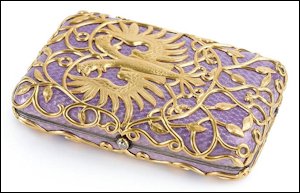
Cigarette Case, Gift from Empress Alexandra to Emperor
Nicholas II, on the Occasion of the Birth of Their Second
Daughter Tatiana, Inscribed From your loving Alix, Peterhof,
29 May 1897, Sold for $317,000
(Courtesy Bonhams London, June 5, 2013, Lot 137)

Imperial Presentation Table Portrait by Henrik Wigström,
Miniature by Vasilii Zuiev, 1909
(Courtesy Sotheby’s New York, April 16, 2013,
Lot 87, $413,000)
Tim Adams, Fabergé Research Newsletter contributor, and Tatiana Fabergé, great granddaughter of Carl Fabergé,
discuss objects in the Artie and Dorothy McFerrin Collection
(Updates are posted in Exhibitions on the Fabergé Research Site)
The Tsars’ Cabinet: Two Hundred Years of Russian Decorative Arts under the Romanovs
Highlights of 200 years of decorative arts under the Romanovs include three cigarette cases, a chamber stick, a cigar box and large diamond studded leather portfolio by Fabergé. (Courtesy Tim Adams)
September 14, 2013 – February 24, 2014 Sainsbury Centre for Visual Arts, Norwich, England
Masterpieces: Art and East Anglia
To celebrate the 50th anniversary of the University of East Anglia and to showcase the royal connections with the Eastern England region, Fabergé objects will be on loan from the Royal Collection Trust of Her Majesty Queen Elizabeth II. A catalog will be published.
Opening in 2014 Hermitage Museum, St. Petersburg, Russia
The Rooms of Karl Fabergé exhibit will open in the General Staff Building to commemorate the 250th anniversary of the founding of the Hermitage Museum.
June 2 – October 12, 2014 Montreal Museum of Fine Arts, Canada
Fabergé Revealed from the Collection of the Virginia Museum of Fine Arts will be on view.
Viktor Vekselberg’s “The Link of Times” Foundation is in the throes of launching a permanent traveling exhibition to … be displayed permanently, but on a rotating basis. The collection, including the Fabergé eggs, will be on show not only in the principal Russian cities of Moscow and St. Petersburg, but also others situated more in the outlying parts of the still vast country, in cities such as Ekaterinburg, Irkutsk, and Tyumen among others. (Jewish Business News, June 23, 2013)
In 2013 during the celebrations of the 400th anniversary of the Romanov reign a memorial plaque of the Tsarevitch Nicholas’ visit was installed and consecrated in the Vladivostok railway station. (Courtesy Paul Kulikovsky, Romanov News)
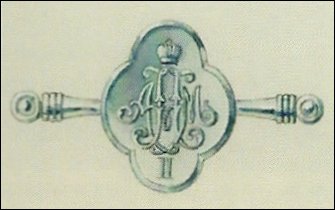
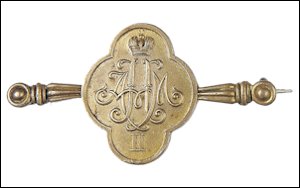
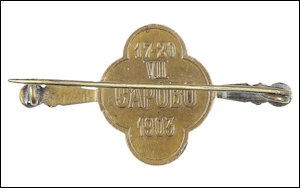
Fabergé Medal Moscow Design Sketch (front only), Blessed Saint Seraphim of Sarov Badge, Bronze Edition, and Variant
(Courtesy Fabergé, Tatiana, et al.; Romanov News compiled by Paul Kulikovsky, April 2013, #59, pt. 2)
A closer examination of the extant badge reveals the design on the front is a crowned monogram of Nicholas II interwoven with letters A and M, probably for the Empresses Alexandra and Marie who were in attendance for the event. The text on the reverse is 17-20 VII Саро́вo 1903. Saint Seraphim of Sarov (1754 or 1759-1833) is one of the most renowned monks and mystics in the Russian Orthodox Church. A memorial service in the Sarov Dormition Cathedral was celebrated on July 18, 1903, with the Imperial Pair in attendance. It was followed by other dedicatory ceremonies through July 22, 1903.
Tatiana Fabergé, daughter of Théodore Carl Agathonovich Fabergé (1904-1971) in her recent publication (Ibid., 166-7) shares the history of her father’s involvement in making Fabergé objects in Paris and Geneva after World War II. His hallmarks are the initials ![]() (Theta Phi) and K. Fabergé in Cyrillic. Three objects with a base similar to the one illustrated in Mme. Fabergé’s book (middle below) are known from the Fabergé literature:
(Theta Phi) and K. Fabergé in Cyrillic. Three objects with a base similar to the one illustrated in Mme. Fabergé’s book (middle below) are known from the Fabergé literature:
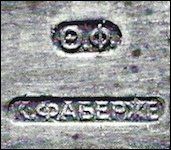
Théodore Carl Fabergé Hallmark

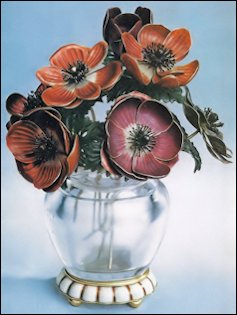
Wild Strawberries and Anemones
(Robert Strauss Collection, Christie’s London, March 9, 1976,
Strawberries realized £39,600, Anemones £20,090)
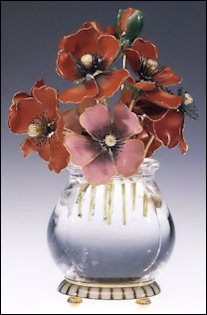
Anemones
(Keefe, Masterworks of Fabergé:
The Matilda Geddings Gray Foundation
Collection, 2008, 74-5)

Imperial Presentation Cigarette Case with Invoice
(Courtesy Mirabaud Collection, Switzerland)
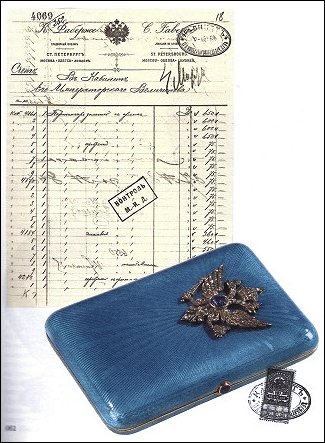
A blue enameled, Fabergé Imperial Presentation case embellished with a diamond and sapphire Byzantine-style eagle is extant. The case’s original invoice shows it was purchased by the Imperial Cabinet on March 1, 1913, for 460 rubles. Russian historian Galina Korneva advises Fabergé researcher Valentin Skurlov believes the case was presented to Leon Nikolayevich “Leonty” Benois (1856-1928), a Russian architect. He helped design many important buildings, including the St. Petersburg Court Choir Chapel, the Grand Ducal Burial Vault connected to the Peter and Paul Cathedral and the Benois Wing of the Russian Museum in St. Petersburg. The presentation date of the case is currently unknown. Does the fact that the case was purchased by the Imperial Cabinet in 1913 make it a possible Tercentenary award?
In discussing this question with Dr. Ulla Tillander-Godenhielm, author of The Russian Imperial Award System (RIAS) for the years 1894-1917, she explained the following points:
- The Cabinet of His Imperial Majesty Nicholas II must have been given directives well ahead of 1913 to commission awards suitable for recipients of various ranks.
- In addition to the Tercentenary celebrations, the Cabinet would have been prepared with awards for worthy individuals at other times during 1913 based on the Table of Ranks. The cigarette cases in question were awarded to individuals with Rank III and below (RIAS, 218, 400-401).
- It is worth noting there are no known documented “Tercentenary” awards for the highest two ranks bearing the dates 1613-1913, the Cap of Monomakh, or Byzantine-style eagles, since these expensive objects were decorated with the emperor’s portrait or cipher.
- To date no protocol documents used by the Imperial Cabinet or a Tercentenary “special committee” to determine eligibility for an award during the official celebrations have been found.
One possible theory regarding any cigarette cases given during the Tercentenary and the rest of 1913 is they all came from the same stock crafted for that year. Perhaps the only feature making a cigarette case truly “Tercentenary” is if it was presented by the Emperor or his designee during the actual 300th Anniversary celebrations held during February and May 1913. To date, I am unaware of any cigarette cases with documentation confirming presentations during the actual Romanov Anniversary events, but given the prevalence of Fabergé Imperial Presentation cases, it seems likely they must exist. I invite readers who have examples with a documented provenance to share the information with the Editors for further study.



